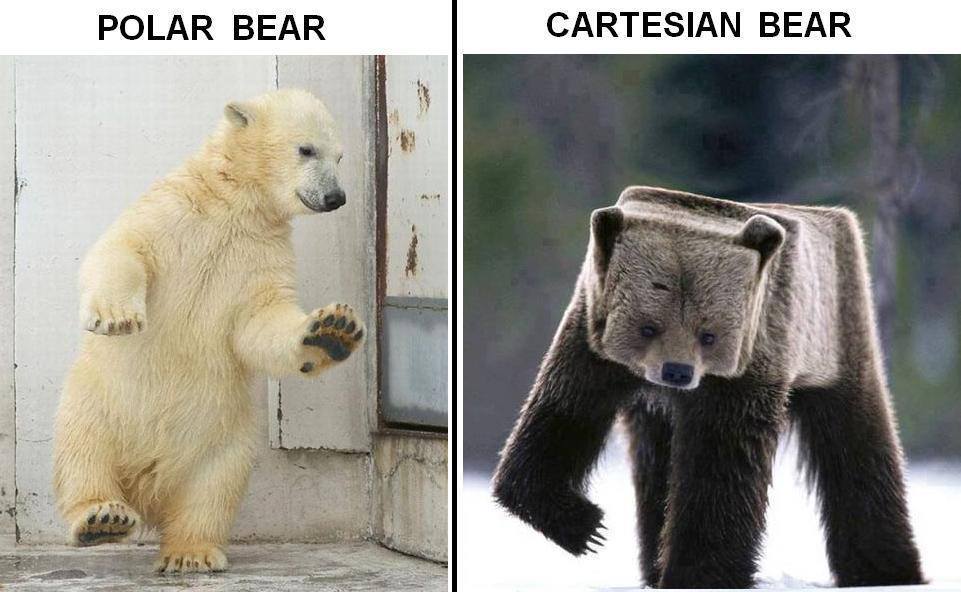


Pacing Tracker
- The quizzes have included questions for 10 objectives. Have you passed at least 80% of them? What are you plans to master those you have't mastered yet?
- We've finished units 1 and 2. Have you started your self-directed learning project for each unit? Ideally you've finished your first SDL, and started (or working on a proposal for) the second.
- Remember you can submit only one SDL project per week, so plan ahead and don't let yourself get behind.
Brain Gains

Draw a bear in polar coordinates, and then Cartesian coordinates.
- Draw a bear in polar coordinates, and then Cartesian coordinates.....
- Find the area of a parallelogram whose edges are the vectors $(a,b)$ and $(c,d)$.
Solution
From problem 20, we learn the answer is $A=|ad-bc|$.
- Find the area of a parallelogram whose edges are the vectors $(-1,3)$ and $(4,2)$.
Solution
Remember the formula $A=|ad-bc|$. Here we have $(a,b) = (-1,3)$ and $(c,d)=(4,2)$, so we get $$A = |(-1)(2)-(3)(4)|=14.$$
- Let $v=u^3$. Also let $x=2u+v$ and $y=u-2v$. Compute $dx$ and $dy$ in terms of $u$ and $du$.
Solution
We have
- $dv = 3u^2du$,
- $dx = 2du+dv$, and
- $dy = du-2dv$.
Replacing $dv$ in $dx$ and $dy$ with $3u^2du$ gives $$dx=2du+dv = 2du+\underbrace{(3u^2du)}_{dv} \quad \text{and}\quad dy=du-2\underbrace{(3u^2du)}_{dv}.$$
This of course also means that $\frac{dx}{du} = 2+3u^2$ and $\frac{dy}{du} = 1-6u^2$, which in turn means the arc length of the curve in the $xy$-plane for $u\in[a,b] $ is $$\int_a^b\sqrt{(2+3u^2)^2+(1-6u^2)^2}du.$$
- Continuing from above, give a vector equation of the tangent line to the curve $v=u^3$ in the $xy$-plane at $u=2$. (What is a point on the curve? What is a direction vector?)
Solution
Note that $u=2$ means $v=8$, so we have $x=2u+v=12$ and $y=u-2v=-14$. We also have $\frac{dx}{du} = 2+3u^2 =14$ and $\frac{dy}{du}=1-6u^2 = -23$. The line passes through $(12,-14)$ and is parallel to $(14,-23)$. The requested equation is $$(x,y) = (14,-23)t+(12,-14).$$
- Draw the region in the plane that satisfies $-1\leq x\leq 2$ and $x\leq y\leq 4-x$.
Solution
We need to be between the vertical lines $x=-1$ and $x=2$. We need to be above the line $y=x$, and below the line $y=4-x$. The region is a triangle with corners at $(-1,-1)$, $(-1,5)$, and $(2,2)$. The height is 6, the width is 3, so the area of this region is 9.
- Compute the double integral $\ds \int_{-1}^{2}\left(\int_{x}^{4-x}1dy\right)dx$.
Solution
We get $$\ds \begin{align} \int_{-1}^{2}\left(\int_{x}^{4-x}dy\right)dx &=\int_{-1}^{2}\left(\int_{x}^{4-x}(1)dy\right)dx\\ &=\int_{-1}^{2}\left(y\bigg|_{y=x}^{y=4-x}\right)dx\\ &=\int_{-1}^{2}[(4-x)-x]dx\\ &=\int_{-1}^{2}(4-2x)dx\\ &=4x-x^2\bigg|_{-1}^{2}\\ &=(8-4)-(4(-1)-(-1)^2) \\ &= 9 . \end{align}$$
Group problems
- Find the area of a triangle with vertices $(1,0)$, $(0,2)$, and $(5,5)$. (Hint: how does a parallelogram relate to a triangle?)
- Consider the curve $v=u^2$ and use the change-of-coordinates $x=2u+v$, $y=u-2v$.
- Since $x=2u+v = 2u+u^2$, we have $\frac{dx}{du} = 2+2u$. Find $\frac{dy}{du}$.
- Give a vector equation of the tangent line to the curve in the $xy$-plane at $u=-2$. [Check: $(x,y) = (-2,9)t+(0,-10)$.]
- Draw the region in the $xy$-plane described by $-2\leq x\leq 1$ and $x\leq y\leq 2-x^2$.
- Compute the integral $\ds\int_{x}^{2-x^2}dy$ (assume $x$ is a constant).
- Compute the double integral $\ds \int_{-2}^{1}\left(\int_{x}^{2-x^2}dy\right)dx$.
- Draw the region in the $xy$ plane described by $\pi/2\leq \theta \leq \pi$ and $0\leq r\leq 5$.
- Compute the integral $\ds\int_{0}^{5}rdr$.
- Compute the double integral $\ds \int_{\pi/2}^{\pi}\left(\int_{0}^{5}rdr\right)d\theta$.
- Draw the region in the plane described by $-3\leq y\leq 2$ and $y\leq x\leq 6-y^2$.
- Compute the integral $\ds\int_{y}^{6-y^2}dx$ (assume $y$ is a constant).
- Compute the double integral $\ds \int_{-3}^{2}\left(\int_{y}^{6-y^2}dx\right)dy$.
- Draw the region in the $xy$ plane described by $0\leq \theta \leq \pi$ and $2\leq r\leq 5$.
- Compute the double integral $\ds \int_{0}^{\pi}\left(\int_{2}^{5}rdr\right)d\theta$.
- Draw the region in the $xy$ plane described by $0\leq \theta \leq \pi/3$ and $0\leq r\leq 2\sin3\theta$.
- Compute the double integral $\ds \int_{0}^{\pi/3}\left(\int_{0}^{2\sin 3\theta}rdr\right)d\theta$.
- Set up a double integral that gives the area of the region in the $xy$ plane that lies inside the cardiod $r=2+2\cos\theta$.
- Set up a double integral that gives the area of the region in the $xy$ plane that lies inside one petal of the rose $r=3\cos2\theta$.
|
Sun |
Mon |
Tue |
Wed |
Thu |
Fri |
Sat |

